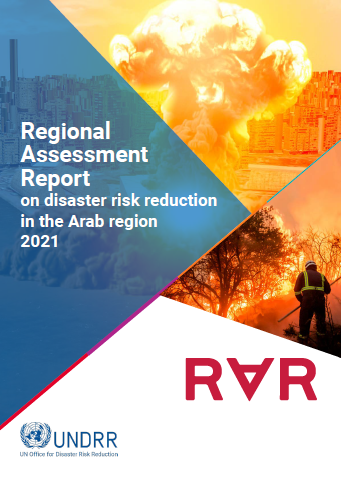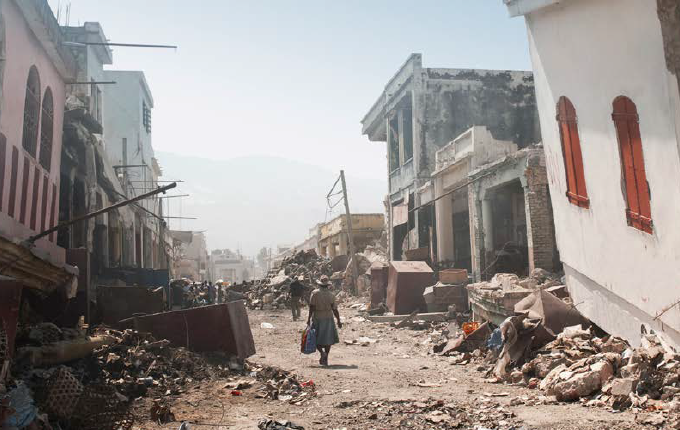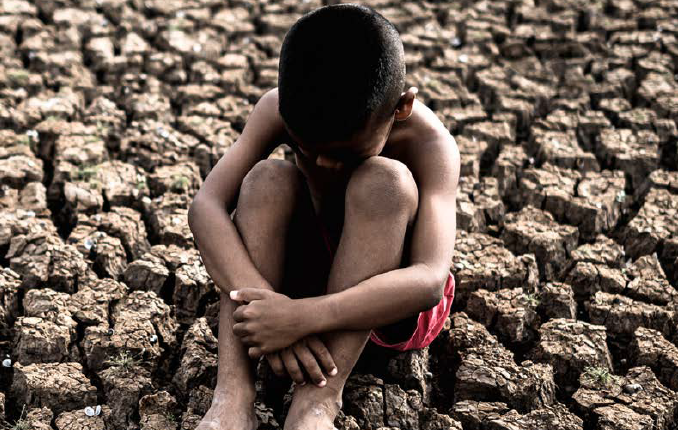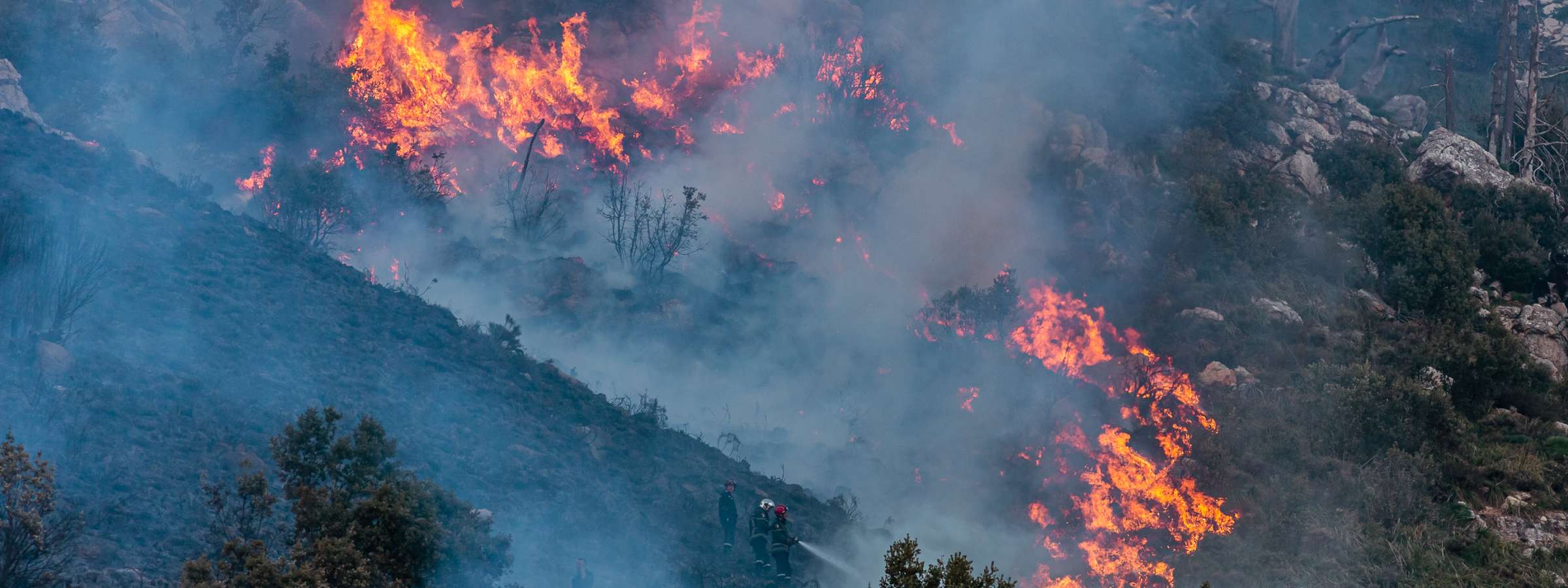2021 Regional Assessment Report for the Arab States
INTRODUCTION
This edition of the Regional Assessment Report on Disaster Risk Reduction in the Arab States (RAR-Arab States) is the first punctuation mark in the implementation of the Sendai Framework in the Arab region. It is influenced by the Global Assessment Report on Disaster Risk Reduction 2019 (GAR19), and offers an update on progress made in implementing the Sendai Framework’s goal, targets, and priorities, while identifying entry points for improving coherence with climate change adaptation and sustainable development. It also provides an analysis of region-specific systemic risk drivers, including a contextualized discussion on vulnerability, rapid urbanization, conflict, and food security.
This report represents a major step towards a twenty-first-century regional view of disaster risk and its reduction. The region is fast approaching the point where it may not be able to mitigate impacts from realized cascading and systemic risk, including the COVID-19 pandemic, superimposed on climate change, conflict, water scarcity, non-sustainable production and consumption patterns, and social vulnerability.

[ Download EN ] [ Download AR ]

This report represents a major step towards a twenty-first century regional view of disaster risk and its reduction. I trust it becomes a ‘go-to-guide’ for governments, policy experts, DRR practitioners and all stakeholders in the Arab region, and proves helpful in supporting efforts to reduce existing risk, and prevent the creation of new risk while strengthening resilience.
Mami Mizutori,
Special Representative of the Secretary-General for Disaster Risk Reduction and
Head of the United Nations Office for Disaster Risk Reduction (UNDRR)
Q&A
CHAPTERS
Chapter 1: Overview of disaster risk in the Arab region
Chapter 1 identifies seven systemic risks, some of which are discussed in detail in later chapters, namely: rural/agricultural risk with rising food insecurity; systemic risk in a rapidly urbanizing region; overdependence on natural resource extraction and non-sustainable consumption and production patterns; the COVID-19 pandemic; cyber risk in cities with advanced infrastructure systems; emerging nuclear energy risks; and the climate change-disasters-conflict migration nexus.

[ Read chapter 1 ]
Chapter 2: Regional progress in disaster risk reduction
Chapter 2 introduces the wider context of the Sendai Framework as one of a group of key international agreements adopted by United Nations Member States in 2015 and 2016 to achieve sustainable development that leaves no one behind and endeavours to reach the furthest behind first. Regional progress in DRR is reviewed at regional, national, sectoral and local levels; and areas where future effort should be directed to effect the desired change in DRR practices identified.

[ Read chapter 2 ]
Chapter 3: Building regional coherence between the three international agendas: climate change, disaster risk reduction and sustainable development
Chapter 3 identifies entry points for building coherence among the three agendas, together with national and local examples, including ecosystem protection and management that engages vulnerable people, addressing gaps in disaggregated data and risk information, climate change national adaptation plans that incorporate sustainable development and disaster risk reduction considerations, innovative financing for building coherence, and capacity building for coherence and financing.

[ Read chapter 3 ]
Chapter 4: Vulnerabilities and capacities in climate change mitigation and adaptation and disaster risk reduction: addressing structural drivers, impacts and empowerment of affected populations
Chapter 4 reviews vulnerability to climate change and disaster risk, including the relationship with distress migration, within the sustainable development paradigm. Recognizing the heterogeneity of populations, both the drivers of vulnerability and impacts in relation to different population segments, sectors, occupations and geographies are analysed. Drawing on an analysis of progress and lessons from good practices at regional, national and community levels, the chapter identifies areas for sustainable reduction in vulnerabilities, resilience building and enhancement of capacities of different population groups to climate change, disaster risks and distress migration. Throughout, the analysis is underscored by a nexus approach that addresses the connectivity between issues and bridges the humanitarian and development agendas.

[ Read chapter 4 ]
Chapter 5: Urbanization trends and urban resilience in the Arab region
Chapter 5 reviews the drivers of urbanization and their interaction with other disaster risk factors, including weak governance, poverty, environmental degradation, conflict, displacement and migration, and unchecked urban expansion, with emphasis on the urban informal settlement growth rates that are a clear manifestation of inequalities in cities. It discusses the pressures that conflict and climate change are exerting on existing urban infrastructure already overburdened due to rapid urbanization rates. The wider context of the New Urban Agenda is introduced, and its linkages and interactions with the other post-2015 sustainable development, climate change and disaster risk reduction agendas. Examples are provided of Arab cities’ efforts to build urban resilience through developing various enabling environments.

[ Read chapter 5 ]
Chapter 6: The disaster-conflict-fragility nexus
Chapter 6 analyses the interface between disaster, conflicts and fragility, outlining overlaps in drivers and consequences, and the compound and mutually reinforcing effects when disasters and conflicts unfold concurrently. Examples and experiences are presented from across the region highlighting the complex relationship between fragility, conflict, and disasters at regional and national levels. Specific thematic areas related to disaster, conflict and fragility relevant to the region are discussed, namely the identification of regionally and nationally relevant policy hooks between DRR and conflict policy architecture, the opportunities and constraints in strengthening the traction of traditional DRR with national stakeholders, ways to increase collaboration between peacebuilding and DRR actors, the importance of understanding typologies of conflict in the identification of strategic opportunities, and the centrality of data in ensuring an evidence-based approach.

[ Read chapter 6 ]
Chapter 7: Food security risks under growing water scarcity
Chapter 7 introduces the four elements of food security, namely availability, access, utilization and stability, and discusses their main trends in the region. It presents the impact of the main hazards related to food security – drought, floods and flash floods, land degradation, transboundary animal and plant pests and diseases, and economic shocks – on the pathways of these four food security elements. Specific recommendations to address each main hazard are put forward.

[ Read chapter 7 ]
Chapter 8: Towards an enabling environment for coherent implementation
Chapter 8 reviews regional practices and challenges encountered in creating an enabling environment for coherent and integrated risk governance at national and local levels. Regional efforts for supporting enabling environments, including institutions and initiatives for risk information, technology and data sharing, are considered. The chapter evaluates the main practices for creating national enabling environments, namely through legal and institutional frameworks, people-centred approaches, technology and data sharing, incentives for investment, and mainstreaming with sustainable development and climate change planning. It then presents challenges and opportunities for creating enabling environments at local level, and discusses entry points for an enabling environment in conflict settings.

[ Read chapter 8 ]
VIDEOS
Message from Mami Mizutori, Special Representative of the Secretary-General for Disaster Risk Reduction
The Regional Assessment Report on Disaster Risk Reduction in the Arab Region
RELATED EVENT
 |
|
Hosted by the Government of Morocco, the Fifth Arab Regional Platform for Disaster Risk Reduction will be organized under the theme “From Risk to Resilience: Accelerating Local Action for Disaster Risk Reduction”, as a virtual event from 8 to 11 November 2021. Visit the official website of the fifth Arab Regional Platorm for Disaster Risk Reduction
|












